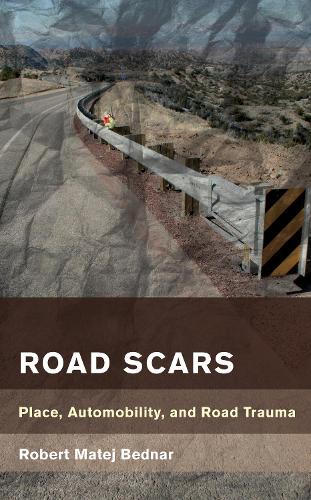
Road Scars: Place, Automobility, and Road Trauma
(Hardback)
Publishing Details
Road Scars: Place, Automobility, and Road Trauma
By (Author) Robert Matej Bednar
Bloomsbury Publishing PLC
Rowman & Littlefield International
21st July 2020
United Kingdom
Classifications
Professional and Scholarly
Non Fiction
363.125
Physical Properties
Hardback
272
Width 164mm, Height 237mm, Spine 21mm
558g
Description
Despite the ubiquity of automobility, the reality of automotive death is hidden from everyday view. There are accident blackspots all over the roads that we use and go past every day but the people that have died there or been injured are not marked, unless by homemade shrines and personal memorialization. Nowhere on the planet is this practice as densely actioned as in the United States.
Road Scars is a highly visual scholarly monograph about how roadside car crash shrines place the collective trauma of living in a car culture in the everyday landscapes of automobility. Roadside shrinesor road trauma shrinesare vernacular memorial assemblages built by private individuals at sites where family and friends have died in automobile accidents, either while driving cars or motorcycles or being hit by cars as pedestrians, bicyclists, or motorcyclists. Prevalent for decades in Latin America and in the American Southwest, roadside car crash shrines are now present throughout the U.S. and around the world. Some are simply small white crosses, almost silent markers of places of traumatic death. Others are elaborate collections of objects, texts, and materials from all over the map culturally and physically, all significantly brought together not in the home or in a cemetery but on the roadside, in drivable public spacea space where private individuals perform private identities alongside each other in public, and where these private mobilities sometimes collide with one another in traumatic ways that are negotiated in roadside shrines. This book touches on something many of us have seen, but few have explored intellectually.
Reviews
With great precision and depth, Bednar (Southwestern Univ.) examines highway road shrines in this well-written, thoughtful volume. A professor of communication studies, Bednar focuses his anthropological gaze on the social meanings of roadside memorials found along the nations highways. He conceives these structures as commemorations of the traumatic deaths of loved ones who perished at the given sites, and also as messages to passing motorists, reminding them of the societal loss and potential dangers inherent at these locations. Bednars painstaking analysis is especially shown through his review of the wide-ranging literature. The text is enhanced by rich color photographs displaying representative shrines found on roadways throughout the southwestern states of the US, which vividly buttress the author's analytical contentions. . . Crucially, Bednar devotes significant attention to explaining how impromptu road shrines differ from established public memorials. In sum, this absorbing and illuminating book provides an encyclopedic grasp of a neglected yet fascinating subject. . . Summing Up: Recommended. All readers. * Choice Reviews *
Here, beautifully presented like gifts to the reader, roadside shrines mourn lives lost on the spot with stuffed animals, dolls, and footballs that mold and crumble, and are replaced and updated with big girl dolls as if the materials of mourning were leading their own lives forward. Scars of trauma perform for a public of strangers the melancholia of being in something unknown but pressing with others. -- Kathleen Stewart, Professor of Anthropology, University of Texas
Robert Bednar has spent almost two decades mapping and photographing thousands of roadside car crash shrines, especially in the American Southwest. This cogent, well-theorized, and heartfelt account focuses on their traumatic affect, making a strong case for their disturbing significance as signs, and scars, of the nations troubling, and enduring, dependence on automobility. -- Erika Doss, Professor of American Studies, University of Notre Dame
Based on more than fifteen years of research, Robert Bednars book is a ground-breaking look at these seemingly silent sentinels. With particular attention to the role of photography, Bednars unique transciplinary approach lays the groundwork for a provocative analysis of the collective agency these memorials exert as manifestations of cultural trauma. Challenging us to recognize societys responsibilities to such trauma, Bednar calls upon us all to bear witness. -- Holly Everett, Head of the Department of Folklore, Memorial University
Author Bio
Robert Matej Bednar is associate professor of communication studies; chair, Strategic Planning + Budget Committee; and co-coordinator of the Situating Place Paideia Cluster, Southwestern University, Georgetown, Texas.
